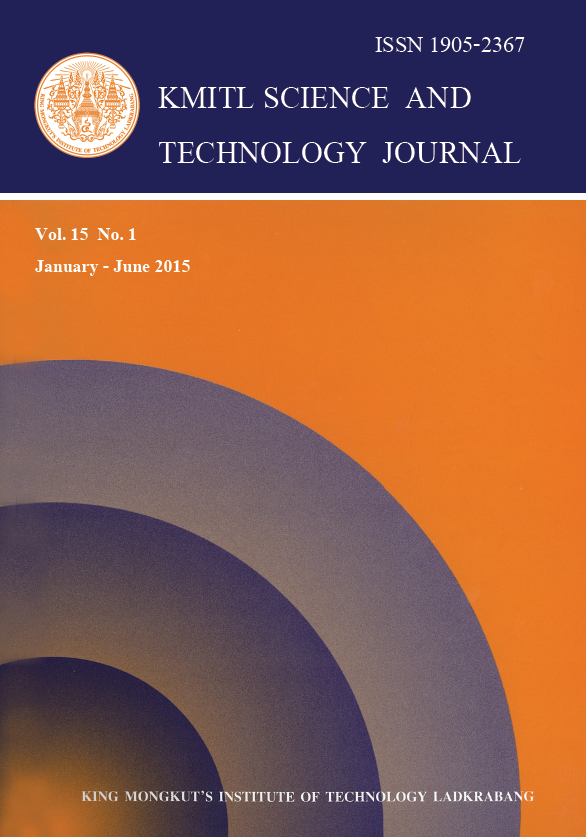Reverse Vending Machine and Its Impacts on Quantity and Quality of Recycled PET Bottles in Thailand
Main Article Content
Abstract
Polyethylene Terephthalate (PET) has been one of the most favorable beverage packaging materials worldwide. Most used PET bottles would become waste after their usage. In many countries such as Germany and the United States, Reverse Vending Machine (RVM) has been widely used to collect recyclable wastes including PET bottles from consumers as part of their recycling and reverse logistics programs. Such machine helps increase quantity and quality of recycled PET bottles. However, RVM is still relatively new in Thailand. Therefore, this study has been conducted to learn acceptance of the machine by consumers along with its impact on quantity and quality of recycled PET bottles. The study has found that approximately 21% more of PET bottles were collected when a RVM is installed in the study area compared to its Business as Usual (BAU) waste collection in the area, which relies solely on building janitors to collect waste. In terms of waste quality, PET bottles collected by the machine were well homogenous with minimal contents of other kinds of materials (e.g., residual contents, caps, and straws).
Keywords: Municipal solid waste, recycle, materials recovery facility, reverse logistics, reverse vending machine.
*Corresponding author: E-mail: ktronnac@kmitl.ac.th
Article Details
Copyright Transfer Statement
The copyright of this article is transferred to Current Applied Science and Technology journal with effect if and when the article is accepted for publication. The copyright transfer covers the exclusive right to reproduce and distribute the article, including reprints, translations, photographic reproductions, electronic form (offline, online) or any other reproductions of similar nature.
The author warrants that this contribution is original and that he/she has full power to make this grant. The author signs for and accepts responsibility for releasing this material on behalf of any and all co-authors.
Here is the link for download: Copyright transfer form.pdf
References
[2] Marichek, K.J. 2000. The Importance of Recycling to the Environmental Profile of Metal Products, Fourth International Symposium on Recycling of Metals and Eng, ineered Materials, pp. 19-28.
[3] Department of Environment, 2010. Climate Change and Water NSW (DECCW), Environmental Benefits of Recycling.
[4] Krumwiede, D.W., and Sheu, C.A., 2002. Model for Reverse Logistics Entry by Third-party Providers, Omega, 30(5), 325-333.
[5] Well, F., 2011. Twenty Years of PET Bottle to Bottle Recycling, Resources, 55(11), 865-875.
[6] Chiemchaisri, C., Juanga, J.P., and Visvanathan, C., 2007. Municipal Solid Waste Management in Thailand and Disposal Emission Inventory, Environ. Monit. Assess.
[7] The Waste & Resources Action Programme (WRAP), 2006. “Materials Recovery Facilities,”
[8] Foppes, N., 2000. http://ms.ist.cmu.ac.th
[9] Brachet, P., Høydal, L.T., Hinrichsen, E.L., and Melum, F., 2008. Modification of Mechanical Properties of Recycled Polypropylene from Post Consumer Containers, Waste Management, 28(12), 2456-2464.
[10] The Association of Postconsumer Plastic Recyclers, 2013. APR Design for Recyclability Guidelines: An Executive Summary.
[11] National Association for PET Container Resources (NAPCOR), 2012. Full-Wrap Shrink Labels: Their Impact on PET Bottle Recycling and Sustainability.
[12] Californians Against Waste (CAW), 2012. Cal Recycle Supports Reverse Vending Machine, http://www.cawrecycles.org.
[13] Ananchon, P., 2011. Feasibility Study of Auto Vending Machine for PET Bottle in Kasetsart University, Master’s independent study, Kasetsart University.
[14] Surry, D.W., 1997. Diffusion Theory and Instructional Technology, http:// intro.base.org/docs/diffusion.
[15] National Innovation Agency (NIA), 2011. Honorable Mention in Social Category, Innovation Link, http://www.nia.or.th/innolinks/page.php? issue=201110§ion=20.


